
* The 1960s were the great era of "vertical take-off & landing (VTOL)" aircraft, with a large number of different prototypes, some of them pretty wild, built and test-flown. The Germans were among those who tinkered with the technology, developing three jet VTOL aircraft in that era, including the EWR "VJ 101C" fighter, the Dornier "Do 31" transport, and the VFW "VAK 191B" fighter. As with most of the early VTOL designs, they were technically interesting but not judged practical for operational use, and never entered production. This document provides a history and description of these German jet VTOL aircraft.
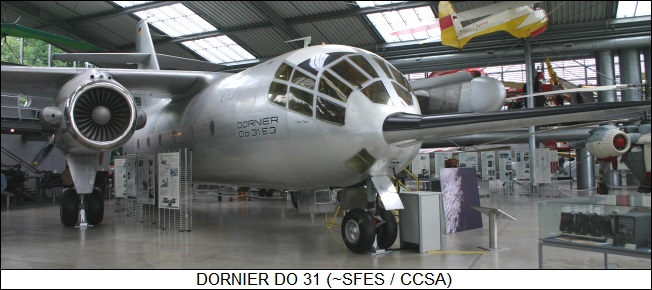
* During World War II, German aircraft designers came up with a set of concepts for VTOL aircraft, most fighters of "tailsitter" or "pogo" configuration, with the aircraft taking off and landing pointing upward. Nothing much came of them, and work elsewhere on pogo aircraft showed they weren't a very good idea, at least for 20th-century aviation technology.
In the late 1950s, the German Heinkel firm began to investigate a VTOL jet fighter -- the idea being that, in case of a Soviet attack, VTOL would support dispersal of combat aircraft assets to small and easily concealed operating bases. Heinkel engineers initially focused on the pogo configuration, but by that time experience with pogo demonstrator aircraft had shown they were a nonstarter, and so interest quickly moved on to a "tiltjet" configuration, in which jet engines were mounted in wingtip pods that could be tilted straight up or horizontal for vertical or forward flight respectively.
A tiltjet machine had already been flown, the US Bell company having thrown together a demonstrator designated the "Model 65 Air Test Vehicle (ATV)", using:
It also featured a Turbomeca Palouste auxiliary power unit (APU) to drive wingtip compressed-air "puffer" control system with thrusters in the wingtips and tail, puffer systems being a common element in VTOL jets to permit flight control in hover.
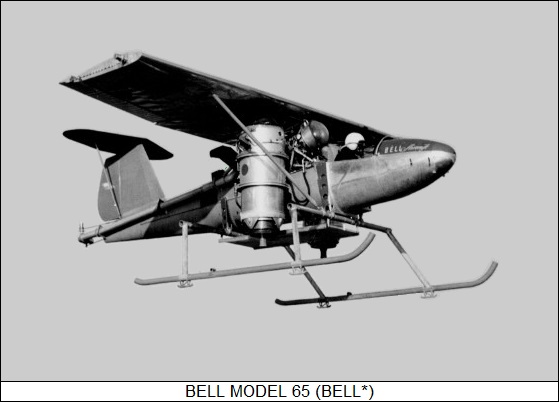
The ATV performed its initial flight on 16 November 1954, though the flight test program was short-lived; it did demonstrate useful VTOL technologies, but it was a very limited machine, being painfully underpowered, and its potential was quickly exhausted. The US Air Force worked with Bell to develop an operational tiltjet fighter, the "XF-109", but nothing came of it. The ATV ended up in the hands of the Smithsonian Air & Space Museum, being placed in storage where it remains at last notice.
The Germans liked the tiltjet concept and followed it up. By mid-1958, Heinkel had roughed out the configuration of the "He 231" tiltjet fighter, attracting the interest of the German government. Since development of a VTOL fighter promised to be a challenge for a single firm, the West German government encouraged Heinkel, Boelkow, and Messerschmitt to collaborate on the effort. In early 1959, the three firms formed a joint organization, Entwicklungsring Sud (EWR Sud / Development Group South), to build the aircraft, which was given the designation of "VJ 101", where "VJ" stood for "Versuchsjaeger (Research Fighter)".
* EWR engineers began by visiting Britain to inspect the Short SC.1 demonstrator, at the time arguably the most advanced VTOL aircraft in the world. The visitors also became interested in work by the British Rolls-Royce engine firm, which had been working on "liftjets" -- relatively small jet engines that could generate high thrust levels for a short period of time to get a VTOL aircraft off the ground.
A number of different configurations for the VJ 101 were considered. The initial concept, the "VJ 101A", featured a canard layout, with dual lift-thrust jets on each wingtip and a single jet on the tips of each canard fin; all the jets tilted up for VTOL operation. The "VJ-101B", in contrast, had a tailed delta layout, with all the engines in the fuselage, including two forward-thrust afterburning turbojets in the rear fuselage, with diverter exhausts for VTOL operation, and twin liftjets mounted vertically behind the cockpit.
After some puzzling about, the decision was made to combine the two concepts in the "VJ 101C", which would have twin tilting jets on each wingtip and twin liftjets behind the cockpit -- it had much the same configuration as the proposed Bell XF-109. The VJ 101C didn't require a puffer system; it was to maneuver in hover by differentially tilting the engine pods and selective control of engine thrust. The go-ahead was given for two prototypes in the spring of 1960. The way to the prototypes was paved by a series of "flying bedframe" demonstrators based on the Rolls-Royce RB.108 liftjet, with a maximum thrust of 10.4 kN (1,060 kgp / 2,340 lbf).
The first was the "Wippe (Seesaw)". It wasn't actually a "flying" demonstrator, being a frame fixed to the ground with a pivoting arm that could move up and down like a seesaw, featuring a "pilot's" seat at the end with an RB.108 directly behind. This item was used to investigate RB.108 throttle response; since the VJ 101C was completely reliant on engine thrust to stay aloft in vertical flight, it was imperative that the RB.108's throttle responsiveness be very well understood. Test with the Wippe began in the spring of 1960, being mostly conducted by George Bright, EWR's American test pilot. With the engine right behind the exposed pilot's seat, one suspects it was a noisy ride.
The second demonstrator was the "Schwebestegell" hover test rig, which was a crucifix-shaped frame with a pilot's seat at the base of the crucifix, an RB.108 right behind the pilot's seat, and an RB.108 in each arm of the crucifix. It was designed to evaluate how well the three-point configuration of the VJ 101C could handle hovering. It was originally flown connected to a telescoping pillar, the first such test being on 1 March 1962; Bright made the first free flight on 13 March. For free flights, the hover rig was fitted with a canvas underbody of sorts to evaluate "ground effect", factoring what the exhaust backblast from the surface below the rig might do to handling. The hover rig also worked out well, being used to test out different manual and automatic flight control systems.
BACK_TO_TOP* In the meantime, in 1961 NATO had issued a specification, the "NATO Basic Military Requirement 3 (NBMR-3)", for a VTOL fighter / reconnaissance platform for frontline combat support, to replace the Fiat G.91 light attack aircraft. Later the requirement would be split into two specs for VTOL combat aircraft -- one a subsonic attack aircraft, the other for a Mach 2 air superiority aircraft.
The VJ 101 seemed to fit NBMR-3 as it was specified at the outset, and work went forward on the first VJ 101C prototype, the "X1". A new powerplant, a derivative of the RB.108 designated the "RB.145" was developed for this machine by a collaboration between Rolls-Royce and MAN Turbo of Germany. The RB.145 added another compressor stage to get nine stages and provided a maximum dry thrust of 12.3 kN (1,250 kgp / 2,750 lbf); it could also be used for sustained thrust. Initial bench tests of the RB.145 had been conducted in 1961.
The VJ 101C X1 was ready for testing in late 1962. It had a distinct resemblance to the Lockheed F-104 Starfighter, with a spikelike fuselage and tricycle landing gear -- all with single wheels, all retracting backward into the fuselage. However, it was hardly a "VTOL Starfighter", EWR engineers simply finding the F-104 inspirational. The VJ 101C X1 obviously differed from the Starfighter in having a conventional instead of tee tail, and high-mounted swept wings, with a leading-edge sweep of 39 degrees, instead of mid-mounted wedge-shaped wings -- and particularly differed from the F-104 in its engine arrangement, being fitted with a total of six RB.145 engines:
The futuristic appearance of the VJ 101 led to it being nicknamed the "Traumjaeger (Dream Fighter)". The VJ 101C X1 was strictly a demonstrator, the RB.145 not having adequate power for an operational machine. Aside from the propulsion system, there was absolutely nothing fancy about it, the aircraft being equipped only with test telemetry systems on top of basic avionics.
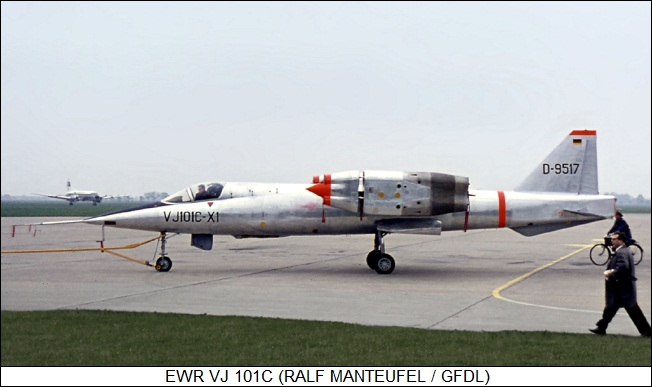
It did have a pressurized cockpit and a Martin-Baker GA7 ejection seat, an early "zero-zero" seat with rocket boost to get a pilot safely out of the aircraft at zero speed and zero altitude. Up to that time, ejection seats had generally needed some minimum speed and altitude to work safely, but since a VTOL machine could come to grief hovering just above the ground, zero-zero operation was absolutely essential.
Bright began tests on an improved telescoping ground fixture on 19 December 1962, with initial hover flight on 10 April 1963, the press being invited to observe a test flight a month later. Bright performed the first conventional take-off and landing in the X1 on 29 August 1963, and through the fall methodically pushed the machine through its envelope until he could take off vertically, transition to forward flight, transition back to vertical flight, and then land. The sophistication of the flight control system was such that transition from vertical to horizontal flight and the reverse, a tricky "three-handed" operation in the British Harrier jumpjet, was not particularly troublesome.
On 29 July 1964, Bright broke Mach 1 in a shallow dive -- but the X1 went out of control on conventional take-off due to an autopilot glitch and was lost on 14 September of that year, Bright ejecting safely. That didn't stall the program for long, with the "VJ 101C X2" beginning tests on 27 October, performing its first free hover on 12 June 1965, working up to full vertical-horizontal-vertical flights by the fall.
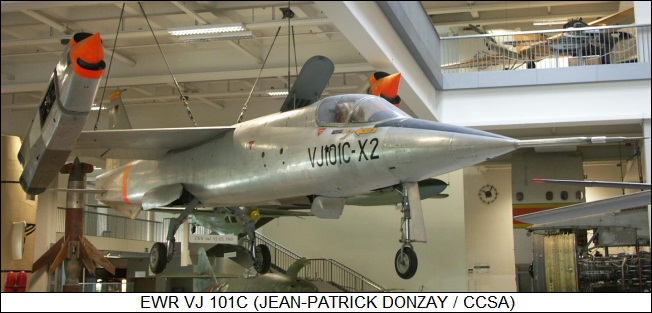
The X2 was very similar to the X1 except for using afterburning RB.145s, designated "RB.145R", with a maximum afterburning thrust of 16.2 kN (1,655 kgp / 3,650 lbf), and with longer tilting wingtip nacelles to accommodate the afterburning engines. Bright eventually got it up to Mach 1.14 in level flight. The engines proved temperamental in VTOL mode, but by that time the momentum was draining out of the program anyway.
___________________________________________________________________
EWR VJ 101C X2:
___________________________________________________________________
wingspan:
6.61 meters (21 feet 8 inches)
wing area:
18.6 sq_meters (200 sq_feet)
length:
15.7 meters (51 feet 6 inches)
height:
4.13 meters (13 feet 6 inches)
MTO weight:
8,000 kilograms (17,640 pounds)
max speed at altitude:
Mach 1.14
___________________________________________________________________
Nobody had ever seen the VJ 101C as an operational machine, the RB.145 engines not having the power to haul operational loads. The expectation was to move on to a Mach 2 "VJ 101D" with Rolls-Royce / MAN RB.153 afterburning engines, providing 53.8 kN (5,490 kgp / 12,100 lbf) thrust, but the engine was simply too big to work in pivoting wingtip pods. As a result, the design concept for the VJ 101B was dusted off, with the VJ 101D envisioned as having two RB.153 liftjets with pivoting exhausts in the rear fuselage, and a row of five RB.162 advanced liftjets behind the cockpit.
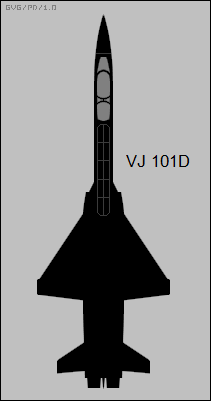
The VJ 101D by all appearances would have been an operationally useful and indeed impressive aircraft -- but it was also complicated, and there was the question of exactly how much benefit a supersonic VTOL fighter really offered over a conventional take-off fighter. The more people looked at the VJ 101D, the less attractive the idea seemed. It was never built, with the VJ 101 development program finally given the axe in 1968; NMBR-3 came to nothing in the end. A two-seat "VJ 101C X3" also remained unbuilt. However, the VJ 101C X2 continued to fly various flight trials until 1971, when it was passed on to the Deutsches Museum in Munich, where it still resides today.
BACK_TO_TOP* Following up on the NMBR-3 requirement, in 1962 NATO then issued the NMBR-4 requirement, which was for a VTOL transport to service the dispersed bases from which the NMBR-3 VTOL fighters were to operate. In response, the German Dornier firm began work on a demonstrator for a VTOL transport, which was given the designation of "Do 31".
As envisioned, the Do 31 would feature a pod on each wingtip with a set of vertically-mounted Rolls-Royce liftjets, plus a Bristol-Siddeley Pegasus vectored-thrust engine mounted at the middle of each wing. The Pegasus was being developed for what would emerge as the Harrier, the engine being a turbofan featuring four rotating, side-mounted exhausts to permit both horizontal and vertical thrust. The West German government authorized development of two flying "bedframes" for technology demonstration, and three Do 31 prototypes.
The first "bedframe" was the "systems test rig" or "small hover rig", which was merely a cross-shaped flying bedframe, with four RB.108 lift engines -- one in each "wingtip" and one in "midwing" -- and the engines feeding a bleed-air puffer system in the tail. It was used to investigate control and stability issues, beginning test flights in April 1964.
The second "bedframe" was the "large hover rig", which actually had some resemblance to the intended Do 31 design, with twin Pegasus 5 engines and a pod on each wingtip with three RB.162 lift engines. It had a more or less proper canopy, a simple cylinder for a main fuselage, an exposed metal frame for a tail, and fixed landing gear. After a long series of tests on a telescoping ground rig, the large hover rig performed its first free flight on 7 February 1967.
The first Do 31 prototype, the "Do 31E-1", performed its initial flight only two days later, on 9 February 1967. It had the full Do 31 airframe, but no liftjets in the wingtip pods, flying solely on its twin Pegasus 5 engines in conventional take-off mode only. The "Do 31E-2" never flew, being a static evaluation machine that was tested to destruction. However, the third prototype, the "Do 31E-3", was fully functional, performing its initial flight in conventional take-off mode on 14 July 1967. The test pilot was another American, Drury W. Wood. The rest of the year was spent in extending the machine's envelope, with the first full vertical take off, transition to horizontal flight, transition back to vertical flight, and vertical landing in January 1968.
* The Do 31 had a fairly typical cargolifter fuselage, with a high tail, a rear loading ramp, and a greenhouse-style cockpit -- along with a capacity of about a fully equipped platoon of troops, or payloads of 3 tonnes (3.3 tons). It had a fold-down "airstair" door on the forward left side of the fuselage for crew access, and escape hatches above the cockpit. It featured tricycle landing gear, all gear assemblies with twin wheels and retracting backwards, the main gear tucking into the main engine nacelles. It had a high wing, straight in the back and with a slight sweep up front, with ailerons outboard and flaps inboard; it had a conventional tail arrangement, with a swept tailfin and a mid-mounted tailplane with a form factor similar to the wing.
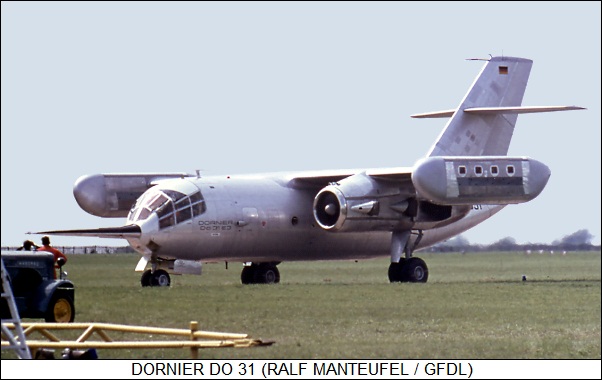
The Do 31's engine arrangement was what made it interesting. It was fitted with a total of ten engines:
The nozzles of the RB.162s could be vectored 15 degrees fore and aft; it appears, sources are not clear on this, that vectoring of the engines in one pod was independent of the vectoring in the other pod to permit yaw control in hover, with the relative thrust of each pod throttled to perform roll trim -- nobody would actually try to perform a roll in hover, of course. A control system ensured that if a liftjet engine in one pod went offline, its equivalent in the other pod was shut down as well, to prevent the aircraft from flipping over. There was a bleed air puffer unit in the tail to provide pitch control. The design arrangement gave the option of deleting the wingtip pods to give a short take-off and landing transport, using Pegasus power alone -- an interesting idea that seems could have led to an effective short-take-off machine, but it appears one that was never seriously pursued.
___________________________________________________________________
DORNIER DO 31:
___________________________________________________________________
wingspan:
18.06 meters (59 feet 3 inches)
wing area:
57 sq_meters (613 sq_feet)
length:
16.4 meters (68 feet)
height:
8.53 meters (28 feet)
MTO weight:
27,500 kilograms (60,500 pounds)
cruse speed:
650 KPH (405 MPH / 3.51 KT)
service ceiling:
10,500 meters (34,500 feet)
range, max payload:
1,800 KM (1,120 MI / 975 NMI)
___________________________________________________________________
By early 1968, the US National Aeronautics & Space Administration (NASA) had acquired an interest in the program, seeing the Do 31 as the basis for a jetliner that could relieve airport congestion. A formal collaborative agreement was signed in early 1969, with NASA constructing a flight simulator stateside to train American pilots, who were then sent to Germany to help put the Do 31 through its paces.
* In the meantime, Dornier worked on the design of a production derivative, the "Do 231", a VTOL jetliner with a passenger capacity of 100. It had only the most general resemblance to the Do 31, looking more like a mutant derivative of a regional jetliner. It seemed conventional enough with its high-mounted swept wing, an RB.230 turbofan with 107 kN (10,900 kgp / 24,000 lbf) thrust under each wing, fairings for main landing gear, and a swept tee tail. It was much more unconventional in having a pod outboard of the engine on each wing containing four RB.202 liftjet turbofans with 58.3 kN (5,940 kgp / 13,100 lbf) each; two more liftjets in the nose and another two in the tail, for a total of twelve; and RB.230 turbofans with vectored exhausts.
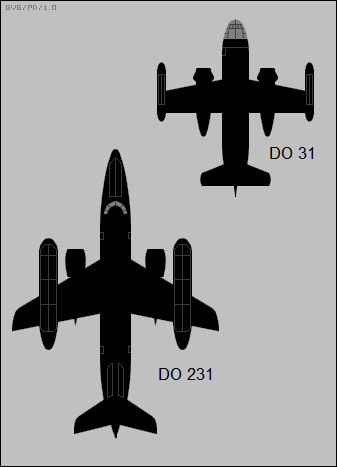
A "Do 231M" military transport was also envisioned, much the same as the Do 231 but with a modified, bulged rear fuselage featuring clamshell loading doors. How the exhaust from the rear two liftjets was routed around the doors is an interesting question.
The Do 231 never came close to happening. The Do 31 flew well enough in evaluations, but analysis of its operating costs showed it to be painfully uncompetitive with conventional-take-off jetliners, such as the Boeing 737. There was also a realization that the facilities required to operate a large CTOL transport were comparable to those of a conventional airfield; the idea of, say, flying off the tops of buildings turned out to be impractical on analysis. The Do 31 was a very interesting machine, but it was of questionable utility, and nobody wanted to follow it up. The program was finally shut down in April 1970, with the Do 31E-3 ending up in the Deutsches Museum along with the VJ 101C.
BACK_TO_TOP* The VJ 101 was not the end of German interest in developing a VTOL fighter to meet the NBMR-3 specification. In 1963, the Germans decided to work on another VTOL fighter, the "VAK 191" -- where "VAK" stood for "Vertikalstartendes Aufklaerungs und Kampfflugzeug (VTOL Reconnaissance & Attack Aircraft)", and the "191" indicated that it was follow-on to the G.91.
After consideration of various options, the effort focused on the "VAK 191B", to be developed in a partnership of VFW of Germany and Fiat of Italy, with six prototypes to be turned out. The VAK 191B was to be built around the Rolls-Royce / MAN RB.193 turbofan, a vectored-thrust engine derived from the Rolls-Royce Spey bypass turbojet with a configuration similar to the Rolls-Royce Pegasus, but smaller and with less thrust -- 45.2 kN (4,600 kgp / 10,150 lbf), about two-thirds the thrust of the Pegasus 5. Since that wasn't enough to get the fighter aloft vertically, an RB.162 liftjet was mounted near-vertically behind the cockpit and in the tail.
Yet another "flying bedframe", the "SG 1262", was developed to support the program. It had no specific resemblance to the VAK 191B as it was projected, being strictly intended to validate control system technologies; the SG 1262 simply consisted of a frame with a pilot's seat up front and five RB.108 liftjets in a row behind it, along with a bleed-air puffer jet on an arm to each side. Initial flights were on a telescoping ground rig, with first free flight on 5 August 1966, VFW chief test pilot Ludwig Obermeier at the controls.
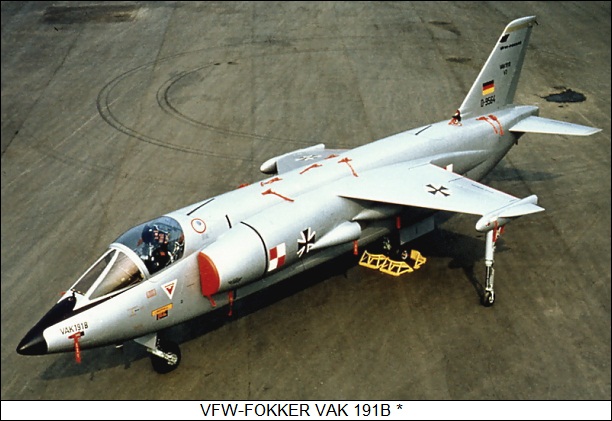
By that time, however, the program was slowing down, NATO having lost interest in the NMBR-3 effort. In 1966, the decision was made to reduce the VAK 191B program to a strictly experimental effort, with the number of prototypes cut to three, and in 1968 the Italians pulled out of the collaboration. Prototype construction continued, however, with the first prototype being rolled out on 24 April 1970, and after captive tests performing its first flight on 10 September 1971 -- about three years later than originally scheduled. The other two prototypes followed the first into the air over the subsequent months. The prototypes were labeled "VFW-Fokker", the two companies having merged in 1969.
* The VAK 191B had a clear resemblance to the BAE Harrier, not surprising because both were built around a vectored-thrust engine with four rotating nozzles. The engine was of necessity at the center of gravity, with the wing, featuring a leading-edge sweep of 48 degrees, of similar necessity being high mounted. The wing had ailerons and single-piece flaps, the flaps being used effectively as airbrakes.
Both aircraft had a "bicycle" type landing gear arrangement to get around the engine -- twin wheels on the rear gear assembly, one wheel on the front -- and had outriggers near the wingtip, which demanded that the wing feature a steep anhedral droop. Both had a conventional tail arrangement, with the all-moving tailplane also featuring a noticeable anhedral droop. Like the Harrier, the VAK 191B had an elaborate bleed-air puffer system with thrusters in wingtips, tail, and nose to provide three-axis control in hovering flight. It had an APU to support flight operations at forward airfields. The pilot sat under a rear-hinged clamshell canopy, with a negligible rear view, on a Martin-Baker Mark 9 zero-zero ejection seat.
___________________________________________________________________
VFW-FOKKER VAK 191B:
___________________________________________________________________
wingspan:
6.16 meters (20 feet 2 inches)
wing area:
12.5 sq_meters (134.5 sq_feet)
length (no probe):
14.72 meters (48 feet 4 inches)
height:
4.3 meters (14 feet 1 inch)
empty weight:
5,560 kilograms (12,235 pounds)
MTO weight:
8,510 kilograms (18,715 pounds)
max speed at altitude:
Mach 0.92
service ceiling:
15,000 meters (49,200 feet)
operational radius:
370 kilometers (230 MI / 200 NMI)
___________________________________________________________________
Beyond all that, however, the Harrier and the VAK 191B were clearly different machines, most notably in the fact that the VAK 191B had liftjets fore and aft, which also gave it a stockier appearance than the Harrier when seen from the side. As with the Do 31, the liftjets were coupled to make sure that the failure of one wouldn't flip the aircraft over. There were doors on the top and bottom of the lift engines; the doors on top were half-circles that opened to the side, the doors on the bottom were rectangular and opened fore and aft, allowing them to be used to provide a small amount of thrust vectoring.
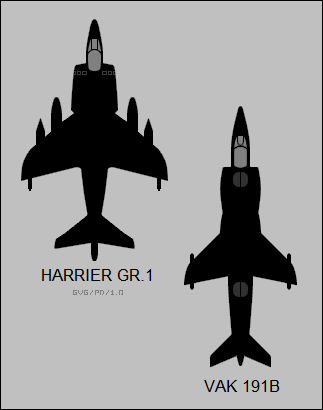
For additional airflow at take-off and landings, as with the VJ 101C the main engine intakes of the VAK 191B slid forward to provide auxiliary airflow. The VAK 191B had a triple-redundant electronic "fly by wire" flight control system -- advanced technology for the era. The aircraft had an internal weapons bay under the main engine, though it was only used to carry test gear in trials, the aircraft being unarmed. A production aircraft was to have external stores pylons and cannon in the bottom of the nose.
The VAK 191B evaluation went well, with 91 flights into 1975, but it was yet another non-starter. As it turned out, the Pegasus continued to be refined to provide more thrust, and the VAK 191B was gradually outstripped by the Harrier, which didn't have to lug around two liftjets that were just dead weight in forward flight. The three VAK 191B prototypes did fly to test avionics for the Panavia Tornado multirole combat aircraft program. All three prototypes have survived, one currently residing at the Deutsches Museum along with the VJ 101C and Do 31E-3 prototypes.
* Roughly in parallel with the VAK 191B program, the US and West Germany collaborated on another short-take-off aircraft project, the "Advanced Vertical Strike (AVS)" aircraft. Following a litter of design studies through the early 1960s by various firms, the AVS program was formally initiated in 1966. As ultimately conceived, the AVS was a fairly tidy large variable-geometry ("swing wing") fighter that had twin vectored-thrust engines in the rear fed by intakes on top of the fuselage, plus two liftjets on each side of the forward fuselage that hinged out for take-offs and landings. It was ingenious in concept -- but also clearly very complicated, likely to be expensive, and it got the axe in 1968. The program eventually led, by no direct path, to West German participation in the Panavia Tornado program.
BACK_TO_TOP* The history of German jet VTOL in the 1960s seems to reflect to a degree the odd tendency of German engineering to be too clever for its own good, churning out ingenious and technically sound designs that proved useless in practice. That's not really fair, however; it more sums up the general infatuation with VTOL in that decade that was hardly restricted to Germany. Dozens of VTOL prototypes were flown around the world, some of them seeming like they had promise -- but the only result of significance of all that effort was, at least in the short term, the BAE Harrier. The big problem was that VTOL, though technically possible, required a number of compromises, and most potential operators didn't see it as a bargain after they balanced the benefits versus the liabilities.
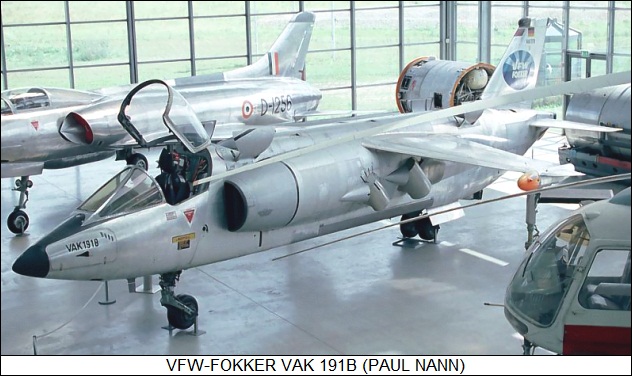
Some observers suggest the refusal to take VTOL more seriously was short-sighted, that in the event of a general European war airfields in Western Europe would be quickly neutralized, and VTOL fighters would then be the only game in town. That's arguable -- one observation being that the Swedes implemented a dispersed airfield scheme known as BASE-90, organized around stretches of reinforced highway, from which combat aircraft without extreme short-take-off capability operated with no great difficulty. If NATO had been serious about airfield dispersal, much the same scheme could have been implemented across Western Europe, and it's hard to say that the dispersed bases for a VTOL combat aircraft would have been any easier to support or more effective.
There was also the question of how credible the idea of a general European war actually was. Both the East and West were armed for such a clash, but neither wanted it, both realizing that a major confrontation was likely to "go nuclear" sooner rather than later, the result being mutual annihilation. In the end, the real question becomes more one of why both sides invested such resources in conventional forces that weren't going to be put to use. The answer's obvious, it was the inevitable result of superpower paranoia -- neither side willing to appear weak, and invite attack by the other.
* Sources include:
* Revision history:
v1.0.0 / 01 oct 12 v1.0.1 / 01 sep 14 / Review & polish. v1.0.2 / 01 aug 16 / Review & polish. v1.0.3 / 01 jul 18 / Review & polish. v1.0.4 / 01 may 20 / Review & polish. v1.0.5 / 01 mar 22 / Review & polish. v1.0.6 / 01 feb 24 / Review & polish.BACK_TO_TOP
